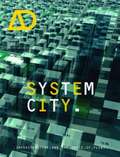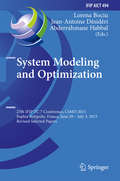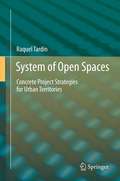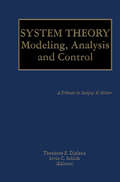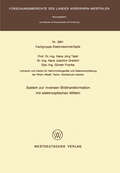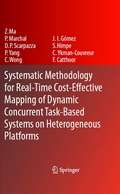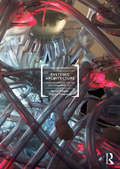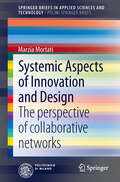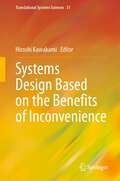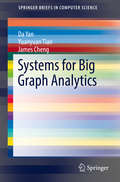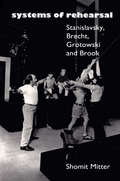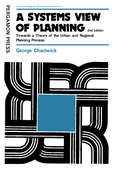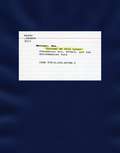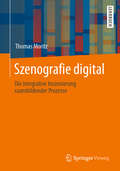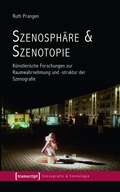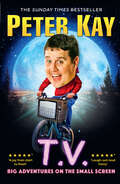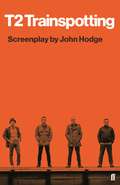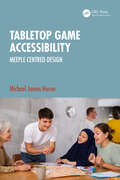- Table View
- List View
System City: Infrastructure and the Space of Flows (Architectural Design)
by Michael WeinstockA radical shift is taking place in the way that society is thinking about cities, a change from the machine metaphors of the 20th century to mathematical models of the processes of biological and natural systems. From this new perspective, cities are regarded not simply as spatially extended material artefacts, but as complex systems that are analogous to living organisms, exhibiting many of the same characteristics. There is an emerging view that the design of the thousands of new cities needed for an expanding world population are to be founded on intelligent and inhabited infrastructural systems or ‘flow architectures’ of urban metabolisms. The physical arrays of the flow architecture of the city are intimately connected to the networks of subsidiary systems that collect and distribute energy, materials and information. They animate the city, and should therefore be intimately coupled to the spatial and cultural patterns of life in the city, to the public spaces through which people flow, and should unite rather than divide urban morphological and ecological systems. Featured architects: AMID(cero9), Buro Happold, Foster + Partners, Groundlab and SOM. Contributors include: Joan Busquets, Kate Davies and Liam Young, Mehran Gharleghi, Evan Greenberg and George Jeronimidis, Marina Lathouri, Wolf Mangelsdorf, Daniel Segraves, Jack Self, Ricard Solé and Sergi Valverde, and Iain Stewart.
System Modeling and Optimization: 27th IFIP TC 7 Conference, CSMO 2015, Sophia Antipolis, France, June 29 - July 3, 2015, Revised Selected Papers (IFIP Advances in Information and Communication Technology #494)
by Lorena Bociu Jean-Antoine Désidéri Abderrahmane HabbalThis book is a collection of thoroughly refereed papers presented at the 27th IFIP TC 7 Conference on System Modeling and Optimization, held in Sophia Antipolis, France, in June/July 2015.The 48 revised papers were carefully reviewed and selected from numerous submissions. They cover the latest progress in their respective areas and encompass broad aspects of system modeling and optimiza-tion, such as modeling and analysis of systems governed by Partial Differential Equations (PDEs) or Ordinary Differential Equations (ODEs), control of PDEs/ODEs, nonlinear optimization, stochastic optimization, multi-objective optimization, combinatorial optimization, industrial applications, and numericsof PDEs.
System of Open Spaces: Concrete Project Strategies for Urban Territories
by Raquel TardinIn the current panorama of urban growth and planning in many urban territories of western societies, open spaces are residual spaces of urban occupation or are reserved for eventual occupation. Open spaces have been viewed in this manner in the earlier stages of the compact city and especially now, in a time of the dispersed territories characterized by discontinuity, heterogeneity, and fragmentation.The disciplinary perspectives of ecology, geology, landscape architecture, and urbanism, but also public opinion, have for some time promoted the conservation and protection of the most valuable natural spaces, and efforts have been made to remove such spaces from the real estate market. However, such positions, usually radical, are insufficient for territorial equilibrium and inevitably lead to the progressive disappearance of valuable natural spaces.
System Theory: Modeling, Analysis and Control (The Springer International Series in Engineering and Computer Science #518)
by Theodore E. Djaferis Irvin C. SchickSystem Theory: Modeling, Analysis and Control contains thirty-three scientific papers covering a wide range of topics in systems and control. These papers have been contributed to a symposium organized to celebrate Sanjoy K. Mitter's 65th birthday. The following research topics are addressed: distributed parameter systems, stochastic control, filtering and estimation, optimization and optimal control, image processing and vision, hierarchical systems and hybrid control, nonlinear systems, and linear systems. Also included are three survey papers on optimization, nonlinear filtering, and nonlinear systems. Recent advances are reported on the behavioral approach to systems, the relationship between differential games and robust control, estimation of diffusion processes, Markov processes, optimal control, hybrid control, stochastic control, spectral estimation, nonconvex quadratic programming, robust control, control algorithms and quantized linear systems. Innovative explorations are carried out on quantum systems from a control theory perspective, option valuation and hedging, three-dimensional medical visualization, computational structure biology image processing, and hierarchical approaches to complex systems, flow control, scheduling and force feedback in fluid mechanics. The contents reflect on past research accomplishments, current research activity, and future research directions in systems and control theory.
System zur inversen Bildtransformation mit elektrooptischen Mitteln (Forschungsberichte des Landes Nordrhein-Westfalen #3091)
by Hans Jörg TafelSystematic Methodology for Real-Time Cost-Effective Mapping of Dynamic Concurrent Task-Based Systems on Heterogenous Platforms
by Zhe Ma Pol Marchal Daniele Paolo Scarpazza Peng Yang Chun Wong José Ignacio Gómez Stefaan Himpe Chantal Ykman-Couvreur Francky CatthoorA genuinely useful text that gives an overview of the state-of-the-art in system-level design trade-off explorations for concurrent tasks running on embedded heterogeneous multiple processors. The targeted application domain covers complex embedded real-time multi-media and communication applications. This material is mainly based on research at IMEC and its international university network partners in this area over the last decade. In all, the material those in the digital signal processing industry will find here is bang up-to-date.
Systemic Architecture: Operating Manual for the Self-Organizing City
by Marco Poletto Claudia PasqueroThis is a manual investigating the subject of urban ecology and systemic development from the perspective of architectural design. It sets out to explore two main goals: to discuss the contemporary relevance of a systemic practice to architectural design, and to share a toolbox of informational design protocols developed to describe the city as a territory of self-organization. Collecting together nearly a decade of design experiments by the authors and their practice, ecoLogicStudio, the book discusses key disciplinary definitions such as ecologic urbanism, algorithmic architecture, bottom-up or tactical design, behavioural space and the boundary of the natural and the artificial realms within the city and architecture. A new kind of "real-time world-city" is illustrated in the form of an operational design manual for the assemblage of proto-architectures, the incubation of proto-gardens and the coding of proto-interfaces. These prototypes of machinic architecture materialize as synthetic hybrids embedded with biological life (proto-gardens), computational power, behavioural responsiveness (cyber-gardens), spatial articulation (coMachines and fibrous structures), remote sensing (FUNclouds), and communication capabilities (Ecological Footprint Grotto). Supporting the authors’ own essays and projects are contributions from key innovators in contemporary architecture and urban design: Michael Batty, Andrew Hudson-Smith, Michael Weinstock and Patrik Schumacher.
Systemic Architecture: Operating Manual for the Self-Organizing City
by Marco Poletto Claudia PasqueroThis is a manual investigating the subject of urban ecology and systemic development from the perspective of architectural design. It sets out to explore two main goals: to discuss the contemporary relevance of a systemic practice to architectural design, and to share a toolbox of informational design protocols developed to describe the city as a territory of self-organization. Collecting together nearly a decade of design experiments by the authors and their practice, ecoLogicStudio, the book discusses key disciplinary definitions such as ecologic urbanism, algorithmic architecture, bottom-up or tactical design, behavioural space and the boundary of the natural and the artificial realms within the city and architecture. A new kind of "real-time world-city" is illustrated in the form of an operational design manual for the assemblage of proto-architectures, the incubation of proto-gardens and the coding of proto-interfaces. These prototypes of machinic architecture materialize as synthetic hybrids embedded with biological life (proto-gardens), computational power, behavioural responsiveness (cyber-gardens), spatial articulation (coMachines and fibrous structures), remote sensing (FUNclouds), and communication capabilities (Ecological Footprint Grotto). Supporting the authors’ own essays and projects are contributions from key innovators in contemporary architecture and urban design: Michael Batty, Andrew Hudson-Smith, Michael Weinstock and Patrik Schumacher.
Systemic Aspects of Innovation and Design: The perspective of collaborative networks (SpringerBriefs in Applied Sciences and Technology)
by Marzia MortatiThe book provides a snapshot of a hot topic – the systemic nature of innovation and its relevance to design – with a trifold perspective: the academic level – the literature on innovation studies and design is often neglected and a clear connection between the two topics taken for granted; the research level – collaborative models are currently considered great opportunities for transforming consumption, production and distribution of goods, but a clear scholarly discourse is still forming; the political level – the European Commission and the OECD are devoting much effort to understanding and measuring the impact of design in innovation processes and firms and a clear contribution would greatly support this path. Thus the book provides an informed, historical and nuanced perspective to the relationship between design and innovation to contribute to all three levels and to propose a point of view that goes beyond aesthetics and meanings.
Systems Design Based on the Benefits of Inconvenience (Translational Systems Sciences #31)
by Hiroshi KawakamiThis book is about the "benefits of inconvenience (BoI)", providing a new approach to designing innovative systems and opening an alternative viewpoint to readers for looking at the world. BoI says that convenient living has “black boxed” the processes we used to rely on, while BoI is about looking at the benefits that were originally provided by these actions that have been black-boxed. Consider the relationship between humans and artificial objects, or things, newly created by engineering technology. In the past, things were “extensions” of people, but before we knew it, things began to substitute for people. BoI can be a keyword for thinking about the relationship that should come after “substitution”. It is a principle of systems design, one that requires time and effort rather than being convenient without any bother. Leading system scientists, technology creators, service producers, and product designers have contributed to this volume. In the first half of the book, many researchers describe their theory of BoI from the perspectives of systems engineers, value engineers, designers, and innovators. In the second half of the book, examples of implementing BoI are introduced in various fields, such as product design, service design, social robotics, tourism engineering, and human activity support systems. They will support innovations in systems or services. It is generally said that necessity is the mother of invention. In that belief, inconveniences should be eliminated, which can be a motive force for new technological development. On the other hand, this book shows that inconveniences are not something to be eliminated, but, on the contrary, are essential to obtain some benefit, and shows us how to create beneficial inconveniences.
Systems for Big Graph Analytics (SpringerBriefs in Computer Science)
by Da Yan Yuanyuan Tian James ChengThere has been a surging interest in developing systems for analyzing big graphs generated by real applications, such as online social networks and knowledge graphs. This book aims to help readers get familiar with the computation models of various graph processing systems with minimal time investment.This book is organized into three parts, addressing three popular computation models for big graph analytics: think-like-a-vertex, think-likea- graph, and think-like-a-matrix. While vertex-centric systems have gained great popularity, the latter two models are currently being actively studied to solve graph problems that cannot be efficiently solved in vertex-centric model, and are the promising next-generation models for big graph analytics. For each part, the authors introduce the state-of-the-art systems, emphasizing on both their technical novelties and hands-on experiences of using them. The systems introduced include Giraph, Pregel+, Blogel, GraphLab, CraphChi, X-Stream, Quegel, SystemML, etc. Readers will learn how to design graph algorithms in various graph analytics systems, and how to choose the most appropriate system for a particular application at hand. The target audience for this book include beginners who are interested in using a big graph analytics system, and students, researchers and practitioners who would like to build their own graph analytics systems with new features.
Systems of Rehearsal: Stanislavsky, Brecht, Grotowski, and Brook
by Shomit MitterThe gap between theory and practice in rehearsal is wide. many actors and directors apply theories without fully understanding them, and most accounts of rehearsal techniques fail to put the methods in context. Systems of Rehearsal is the first systematic appraisal of the three principal paradigms in which virtually all theatre work is conducted today - those developed by Stanislavsky, Brecht and Grotowski. The author compares each system ot the work of the contemporary director who, says Mitter, is the Great Imitator of each of them: Peter Brook. The result is the most comprehensive introduction to modern theatre available.
Systems of Rehearsal: Stanislavsky, Brecht, Grotowski, and Brook
by Shomit MitterThe gap between theory and practice in rehearsal is wide. many actors and directors apply theories without fully understanding them, and most accounts of rehearsal techniques fail to put the methods in context. Systems of Rehearsal is the first systematic appraisal of the three principal paradigms in which virtually all theatre work is conducted today - those developed by Stanislavsky, Brecht and Grotowski. The author compares each system ot the work of the contemporary director who, says Mitter, is the Great Imitator of each of them: Peter Brook. The result is the most comprehensive introduction to modern theatre available.
A Systems View of Planning: Towards a Theory of the Urban and Regional Planning Process
by George ChadwickA Systems View Of Planning: Towards A Theory of the Urban and Regional Planning sets out to be a special kind of theory of the process known as town and regional planning, which is based upon the broader theory of General Systems and its allied field of Cybernetics. Because of this, the content of the book differs considerably from what most town planners think of as relevant to the subject. The book begins with physical change and human ecology, and then moves on to systems and planning, its goals, projecting the future of the system, operational models and their underlying theories, and management and planning. The book appeals to planners, architects, and city engineers, especially those who wish to learn or make a study on the systems view of planning, its different theories and methods, its possible future, and its many applications in designing and improving towns and cities.
Systems We Have Loved: Conceptual Art, Affect, and the Antihumanist Turn
by Eve MeltzerBy the early 1960s, theorists like Lévi-Strauss, Lacan, Foucault, and Barthes had created a world ruled by signifying structures and pictured through the grids of language, information, and systems. Artists soon followed, turning to language and its related forms to devise a new, conceptual approach to art making. Examining the ways in which artists shared the structuralist devotion to systems of many sorts, Systems We Have Loved shows that even as structuralism encouraged the advent of conceptual art, it also raised intractable problems that artists were forced to confront. Considering such notable art figures as Mary Kelly, Robert Morris, Robert Smithson, and Rosalind Krauss, Eve Meltzer argues that during this period the visual arts depicted and tested the far-reaching claims about subjectivity espoused by theorists. She offers a new way of framing two of the twentieth century’s most transformative movements—one artistic, one expansively theoretical—and she reveals their shared dream—or nightmare—of the world as a system of signs. By endorsing this view, Meltzer proposes, these artists drew attention to the fictions and limitations of this dream, even as they risked getting caught in the very systems they had adopted. The first book to describe art’s embrace of the world as an information system, Systems We Have Loved breathes new life into the study of conceptual art.
Systems We Have Loved: Conceptual Art, Affect, and the Antihumanist Turn
by Eve MeltzerBy the early 1960s, theorists like Lévi-Strauss, Lacan, Foucault, and Barthes had created a world ruled by signifying structures and pictured through the grids of language, information, and systems. Artists soon followed, turning to language and its related forms to devise a new, conceptual approach to art making. Examining the ways in which artists shared the structuralist devotion to systems of many sorts, Systems We Have Loved shows that even as structuralism encouraged the advent of conceptual art, it also raised intractable problems that artists were forced to confront. Considering such notable art figures as Mary Kelly, Robert Morris, Robert Smithson, and Rosalind Krauss, Eve Meltzer argues that during this period the visual arts depicted and tested the far-reaching claims about subjectivity espoused by theorists. She offers a new way of framing two of the twentieth century’s most transformative movements—one artistic, one expansively theoretical—and she reveals their shared dream—or nightmare—of the world as a system of signs. By endorsing this view, Meltzer proposes, these artists drew attention to the fictions and limitations of this dream, even as they risked getting caught in the very systems they had adopted. The first book to describe art’s embrace of the world as an information system, Systems We Have Loved breathes new life into the study of conceptual art.
Systems We Have Loved: Conceptual Art, Affect, and the Antihumanist Turn
by Eve MeltzerBy the early 1960s, theorists like Lévi-Strauss, Lacan, Foucault, and Barthes had created a world ruled by signifying structures and pictured through the grids of language, information, and systems. Artists soon followed, turning to language and its related forms to devise a new, conceptual approach to art making. Examining the ways in which artists shared the structuralist devotion to systems of many sorts, Systems We Have Loved shows that even as structuralism encouraged the advent of conceptual art, it also raised intractable problems that artists were forced to confront. Considering such notable art figures as Mary Kelly, Robert Morris, Robert Smithson, and Rosalind Krauss, Eve Meltzer argues that during this period the visual arts depicted and tested the far-reaching claims about subjectivity espoused by theorists. She offers a new way of framing two of the twentieth century’s most transformative movements—one artistic, one expansively theoretical—and she reveals their shared dream—or nightmare—of the world as a system of signs. By endorsing this view, Meltzer proposes, these artists drew attention to the fictions and limitations of this dream, even as they risked getting caught in the very systems they had adopted. The first book to describe art’s embrace of the world as an information system, Systems We Have Loved breathes new life into the study of conceptual art.
Systems We Have Loved: Conceptual Art, Affect, and the Antihumanist Turn
by Eve MeltzerBy the early 1960s, theorists like Lévi-Strauss, Lacan, Foucault, and Barthes had created a world ruled by signifying structures and pictured through the grids of language, information, and systems. Artists soon followed, turning to language and its related forms to devise a new, conceptual approach to art making. Examining the ways in which artists shared the structuralist devotion to systems of many sorts, Systems We Have Loved shows that even as structuralism encouraged the advent of conceptual art, it also raised intractable problems that artists were forced to confront. Considering such notable art figures as Mary Kelly, Robert Morris, Robert Smithson, and Rosalind Krauss, Eve Meltzer argues that during this period the visual arts depicted and tested the far-reaching claims about subjectivity espoused by theorists. She offers a new way of framing two of the twentieth century’s most transformative movements—one artistic, one expansively theoretical—and she reveals their shared dream—or nightmare—of the world as a system of signs. By endorsing this view, Meltzer proposes, these artists drew attention to the fictions and limitations of this dream, even as they risked getting caught in the very systems they had adopted. The first book to describe art’s embrace of the world as an information system, Systems We Have Loved breathes new life into the study of conceptual art.
Szenografie digital: Die integrative Inszenierung raumbildender Prozesse
by Thomas MoritzIm Buch wird im Kontext individueller Rezipientenpartizipation und Nutzerimmersion erläutert, welche Wahrnehmungsaspekte der performativen Raumbildung immanent sind und warum integratives Inszenieren sie effektiver macht. Integratives Inszenieren erweitert als Bestandteil der Screenografie interaktiv nutzbarer Informations- und Kommunikationssysteme das szenografische Berufsbild und ist für die systematische Entwicklung von grafischen Benutzeroberflächen im Systemischen Design essentiell.
Szenografie digital: Die integrative Inszenierung raumbildender Prozesse
by Thomas MoritzIm Buch wird im Kontext individueller Rezipientenpartizipation und Nutzerimmersion erläutert, welche Wahrnehmungsaspekte der performativen Raumbildung immanent sind und warum integratives Inszenieren sie effektiver macht. Integratives Inszenieren erweitert als Bestandteil der Screenografie interaktiv nutzbarer Informations- und Kommunikationssysteme das szenografische Berufsbild und ist für die systematische Entwicklung von grafischen Benutzeroberflächen im Systemischen Design essentiell.
Szenosphäre & Szenotopie: Künstlerische Forschungen zur Raumwahrnehmung und -struktur der Szenografie (Szenografie & Szenologie #14)
by Ruth PrangenDer Szenografiediskurs weist trotz intensiver Forschung noch immer begriffliche Lücken auf: Wie bezeichnet man die durch eine Szenografie hervorgebrachte Atmosphäre und den im Raum installierten Parcours? Ruth Prangen schlägt hierfür die Begriffe »Szenosphäre« und »Szenotopie« vor, welche sowohl die Raumwahrnehmung der Szenografie mittels phänomenologischer als auch die Raumstruktur anhand (post-)strukturalistischer Analysewerkzeuge erfassbar machen. Dabei kommt ein innovatives künstlerisch-wissenschaftliches Forschungsdesign zur Anwendung, in dem sich Praxis und Theorie begegnen können. Die Ergebnisse werden exemplarisch durch Projekte von verschiedenen Künstler_innen veranschaulicht sowie durch Interviews, darunter mit Werner Ruhnau, und eine Raumbühnenmatrix für zukünftige Inszenierungspraktiken und die Szenografieforschung ergänzt.
T.V.: Big Adventures On The Small Screen
by Peter KayTHE INSTANT SUNDAY TIMES BESTSELLER *The long-awaited return of the comedy national treasure*
T2 Trainspotting
by John HodgeFirst there is an opportunity, then there is a betrayal.Twenty years have gone by.Much has changed but just as much remains the same.Mark Renton returns to the only place he can ever call home. They are waiting for him, of course: Spud, Sick Boy, and Frank Begbie. But they are not alone. Other old friends are waiting too: sorrow, loss, joy, vengeance, hatred, friendship, love, longing, fear, regret, diamorphine, self-destruction and mortal danger, they are all lined up to welcome him, ready to join the dance. Mark Renton returns, to the chaos of life and death.
Tabletop Game Accessibility: Meeple Centred Design
by Michael James HeronThis foundational resource on the topic of tabletop game accessibility provides actionable guidelines on how to make games accessible for people with disabilities. This book contextualises this practical guidance within a philosophical framework of how the relatively abled can ethically address accessibility issues within game design.This book helps readers to build understanding and empathy across the various categories of accessibility. Chapters on each category introduce ‘the science’, outline the game mechanics and games that show exemplar problems, relate these to the real-world situations that every player may encounter, and then discuss how to create maximally accessible games with reference to the accessibility guidelines and specific games that show ‘best-in-class’ examples of solutions.This book will be of great interest to all professional tabletop and board game designers as well as digital game designers and designers of other physical products.
Tabletop Game Accessibility: Meeple Centred Design
by Michael James HeronThis foundational resource on the topic of tabletop game accessibility provides actionable guidelines on how to make games accessible for people with disabilities. This book contextualises this practical guidance within a philosophical framework of how the relatively abled can ethically address accessibility issues within game design.This book helps readers to build understanding and empathy across the various categories of accessibility. Chapters on each category introduce ‘the science’, outline the game mechanics and games that show exemplar problems, relate these to the real-world situations that every player may encounter, and then discuss how to create maximally accessible games with reference to the accessibility guidelines and specific games that show ‘best-in-class’ examples of solutions.This book will be of great interest to all professional tabletop and board game designers as well as digital game designers and designers of other physical products.
